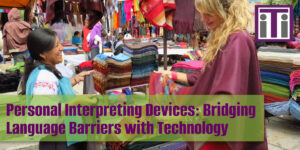Personal Interpreting Devices: Bridging Language Barriers with Technology
Reading Time: ~4 mins

There’s no question: In business, healthcare, and government settings, there is no substitute for a live interpreter. Whether you access them in-person or via a virtual application like over-the-phone (OPI) or video remote interpreting (VRI), a human being with professional interpreter training is always the best option.
But what about your vacation to Lisbon or Tokyo or Costa Rica? If you’re one of those travelers who likes to get off the beaten track, you may find yourself negotiating a price or asking for directions from someone who doesn’t speak English, and bringing along your own personal interpreter is likely not an option.
Personal interpreting devices can be powerful tools to help individuals navigate these language barriers. From portable translation devices to real-time language translators, there are multiple options to choose from.
Types of Personal Interpreting Devices
Handheld Translation Devices
Before the advent of smartphone apps, handheld translation devices were the original personal interpreting tools. These devices are still popular for their reliability and ease of use.
Compact and easy to carry, they are specifically designed for travelers. Typically equipped with high-quality microphones and speakers, they provide clear communication. Many support multiple languages and can function without an internet connection.
Top Sellers in Handheld Translation Devices
- Vasco V4 Language Translator: Supports 112 languages and offers free cellular connectivity for smooth translations.
- Fluentalk T1: Features a 4-inch touchscreen, high-performance CPU, and multiple translation modes.
- Langogo Genesis: Known for its accuracy and ability to function offline.
Phone-Based Translation Apps
Phone-based translation apps are among the most accessible and widely used personal interpreting devices. These apps leverage the power of smartphones to provide instant translations.
These apps can translate spoken words in real-time, making conversations smoother. Users can speak into their phones, and the app will translate their speech into the desired language and, in some cases, then speak the interpreted phrase aloud. Advanced AI algorithms are getting better at accurate translations, even for complex sentences.
Top Sellers in Phone-Based Translation Apps
- Google Translate: Still the granddaddy of translation apps, and still the most widely used.
- iTranslate: Offers voice-to-voice translation and offline capabilities.
- Microsoft Translator: Features real-time translation and integration with other Microsoft services.
Earbud Translation Devices
Earbud translation devices are another innovative solution for personal interpreting. These gadgets are designed to be worn like regular earbuds but come equipped with translation technology.
Their portability and ease of use make them a favorite among travelers. The disadvantage: They are significantly more expensive than hand-held devices and phone apps.
While there are a number of in-ear devices that work with phone apps, Timekettle W2 is considered the gold standard of a device that works independently. It offers real-time translation with high accuracy. Prices run from $300 to $350, depending on features.
How Effective Are Personal Interpreting Devices?
Personal interpreting devices have come a long way in terms of accuracy and usability. They are particularly effective for casual conversations, travel, and everyday interactions. However, it’s important to note that while these devices are great for personal use, they are no substitute for a human interpreter in professional situations.
Advantages of Personal Interpreting Devices
- Convenience: Easy to carry and use anywhere.
- Cost-effective: More affordable than hiring a professional interpreter.
Limitations of Personal Interpreting Devices
- Accuracy: While generally accurate, they can struggle with idiomatic expressions and complex technical language.
- Context: Human interpreters can understand and convey cultural nuances better than machines.
- Reliability: Dependence on internet connectivity can be a drawback in areas with poor signal.
Whether you opt for phone-based translation apps, earbud translation devices, or handheld translation devices, personal interpreting devices offer convenience and accessibility. However, for professional settings, human interpreters remain irreplaceable.
| Learn More |
Founded in 1986, Interpreters and Translators, Inc. is a full-service language solutions provider located in Glastonbury, Connecticut.
iTi is an NMSDC-recognized minority-owned business.





